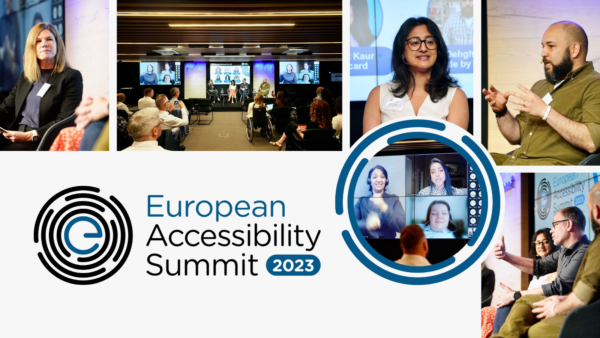On 8 June, several industry representatives and disability rights advocates gathered during the European Accessibility Summit to discuss the current opportunities and trends related to accessibility, especially since the adoption of the European Accessibility Act.
The EU Accessibility Act adopted in 2019 is intended to facilitate greater access to accessible devices, products, and services across the EU. The Accessibility Act applies the concept of truly designing for all, which was established by the United Nations Convention on the Rights of Persons with Disabilities.
So, how has the adoption of the Accessibility Act impacted access to goods and services?
Tommy Zonnekein (SNCB), Radha Gohil (Shell), Gurpreet Kaur (MasterCard), Ali Dehghanpour (Zettle by PayPal), Anna Drabarz (EDF) and Lissa Shook (Microsoft), shared their perspective.
Accessibility in product development and user experience
One of the first points of the discussion focused on accessibility in product development and user experience.
Ali Dehghanpour (Zettle by PayPal) explained that the uniqueness of payment terminals is that both customer and merchant are interacting with the machine, and therefore it must be accessible for both. It also needs to ensure both hardware and software accessibility.
Tommy Zonnekein (SNCB), spoke about the journey of developing an accessible mobile application for his company, the National Railway Company of Belgium, who learned that creating accessible products for all customers needs to go further than just applying regulations. He explained:
We had focus groups with people with disabilities, we had personal interviews, and then we designed the complete customer journey as it was, what was the desired customer journey. We started to write the user stories and develop the application. Always testing with customers with disabilities to focus on what is very important and what are the limitations. that that’s also reality. It is very difficult to create something that is useful for everybody.
One solution the company found to always ensure accessibility measures are incorporated in their products, is feedback through a user panel.
Today, we have a user panel of 400 people with disabilities. When we weren’t doing projects, we asked them to give their opinion on readability from screens in stations. As a result, we bought new ticket vending machines. While there were European regulations coming like the European Accessibility Act, we didn’t know what to do. So, we invited the people and asked their opinion.

Accessibility in design and technology
The discussion led to the realisation that there is not a “one design for all” solution when designing accessible products, and that’s something that Radha Gohil (Shell) has noticed when working on the accessibility of Shell’s forecourts (open area in front of a large building or petrol station):
The key problem is if a person using a wheelchair goes to one of our forecourts, what about the physicality of getting out of the car, filling up the car and then going to pay? That can take quite some time and also isn’t always possible. So how can we bridge that gap?
To solve this issue, she then explained how Shell partnered with an application called “Fuel Service”, that helps drivers with disabilities source a physical location where there would be a person on-site to help them with the actual filling up of the car.
Both Radha Gohil (Shell) and Lissa Shook (Microsoft), who moderated the panel, underlined the fact that those kinds of solutions benefit not only persons with disabilities but a wide range of users.
As for the financial sector, Gurpreet Kaur (MasterCard) added that inaccessible design not only has an impact on persons with disabilities but also on other customers. She used the example of payment cards becoming increasingly flat:
It is making it very difficult for blind and partially sighted people to orient and use their cards.
Then she added about MasterCard’s recent accessible product:
Touch Card (a system that allows consumers to not only correctly orient the card when making a payment or accessing an ATM, but also to know which payment card they are using), is a feature and global card standard that solves the problem of identification of the cards for people who are blind and low vision but also other folks, people who are in rush and trying to figure out which card that they need to get. Touch Card allows consumers to use the right car right way and using touch alone.
Factors impacting the usability of technology for persons with disabilities
Anna Drabarz (EDF Board Member) took the floor to remind participants about an essential part of accessible design: having a comprehensive approach. Accessibility is not just about the product design but everything around it: complaint procedures on products, services or terms and conditions that are clear and understandable for all, clear information products and language to communicate about it. She also talked about the language barrier:
That could be really a challenge for some companies because we are used to talking in legal terms and this not so clear a language.
Regarding other barriers and factors impacting usability, she mentioned:
Sometimes companies focus mainly on some kinds of disabilities, like sensory ones, or mobility disabilities. And addressing the needs, for example, of persons with psychosocial disabilities or persons who have complex communication needs. I think that remains a major challenge just to stretch our look on the issue.
She also insisted on the fact that the lack of representation of persons with disabilities in the design and development process can lead to a lack of understanding of their unique needs and perspectives.
Further explore the topic
If you missed the European Accessibility Summit 2023 and the session on “Enabling an accessible digital work environment”, you can watch the recording of the event.
About the European Accessibility Summit 2023
The 2023 edition of the European Accessibility Summit was organised by the European Disability Forum and supported by Microsoft.
You can find more info on the agenda, speakers and recordings on the event page.